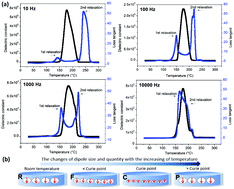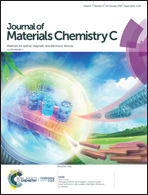Novel prominent nylon-1 with excellent dielectric properties and a high Curie point†
Abstract
Giant-dielectric constant materials have attracted significant attention for energy storage and dielectric applications in power systems and microelectronic devices. However, their development has generally been limited due to the difficulty faced while using them in low or high temperature environments. In this study, a novel material with excellent dielectric properties and a high phase transition temperature is reported. Nylon-1, with the highest density of dipole and –HNCO– groups among all odd-numbered nylons, was studied by broadband dielectric spectroscopy (BDS) for the first time and exhibited a dielectric constant (ε′) of 5.78 × 106 at 10 Hz near the Curie point. The dielectric polarization and relaxation behaviors of nylon-1 have also been discussed in detail. Moreover, the mechanism behind these behaviors is the intrinsic phase transition near the Curie point (Tc) for nylon-1 that is actually due to change in the bulk resistance and capacitance. Especially, the Curie point of nylon-1 is 178 °C, which is much higher than that of other polymers. In addition, the changes in the crystal structure, hydrogen bond and hydrophilicity induced by temperature have been systematically investigated to further improve the Curie point of nylon-1; therefore, large dielectric constant and high phase transition temperature properties of nylon-1 make it a promising material for applications in energy storage in a high-temperature environment.



 Please wait while we load your content...
Please wait while we load your content...